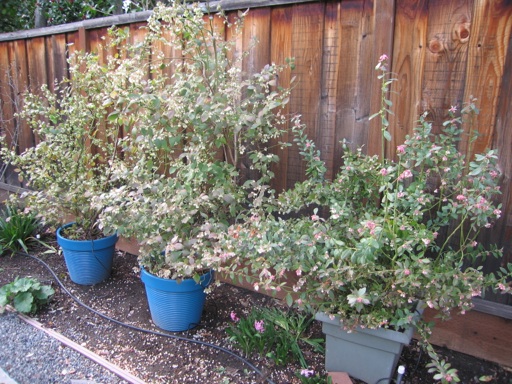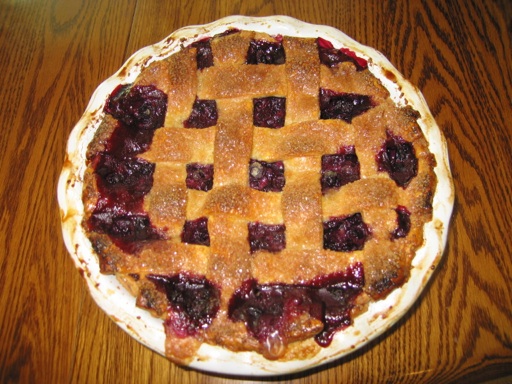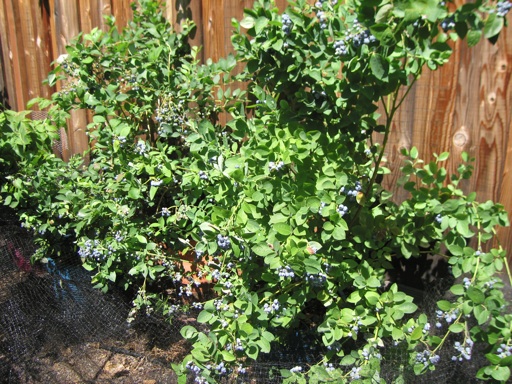Archive for the 'Blueberries' Category
We have 3 cherry trees growing in our backyard. They are about 8 years old. The varieties are Bing, Rainier, and Royal Rainier. In previous years, I have found maggots inside some of the cherries. Last year, most of the cherries were infested with maggots, especially on the Royal Rainier. I noticed small flies buzzing around the fruit. I suspected that the flies were spotted wing drosophila (SWD). Most of the cherries were brown and inedible looking from the insect damage. I ended up throwing all of them away.
I was on the verge of removing all of our cherry trees, because I didn’t want to implement a spraying regime. I had the same problem with raspberries in the past. I sprayed the raspberries back then, but it didn’t help. I ended up removing all of my raspberries. But I wasn’t ready to give up on the cherries just yet. It has taken several years for them to reach the size they are and to start producing fruit. Also, removing the cherry trees now would require much more work than removing raspberries.
So this year I tried something different. I have netted the cherry trees with bird netting in past years to keep birds away, but the holes in bird netting are too large to keep out insects. The only type of netting I am aware of that has a mesh fine enough to keep out small flies is mosquito netting. So earlier this year, I bought some mosquito netting.
After our cherry trees were out of bloom in mid-April, I wrapped mosquito netting around our Royal Rainier cherry tree and tied it with twine around the trunk. I then rolled any open parts of the netting together and sealed the openings with clothes pins to keep insects from flying or crawling in. It helped that I have pruned this tree to keep it under 8 feet tall. I didn’t bother to net the other two cherry trees, because they set very few cherries this year. Here is what our tree looks like netted.

Last weekend, I harvested most of the Royal Rainier cherry crop. Here’s what they looked like inside the tree.

And here is what they looked like after harvest.

They look beautiful and taste amazing. Not one of the cherries appears to have been touched by birds or insects. We have eaten most of them already, and we haven’t found maggots in any of them. The netting also allowed me to leave the cherries on the tree long enough to fully ripen.
Netting a tree is extra work, and it is probably not practical for large trees over 10-12 feet tall. However, I think it was worth the effort. Mosquito netting is easier to work with than bird netting, because it doesn’t get caught on things as easily. And it keeps out all kinds of pests including insects, birds, and squirrels.
In fact, I am so happy with the results of the mosquito netting that I am using it to cover some of my other fruits and vegetables. For example, I am using it to cover broccoli and cauliflower to keep out cabbage moths and aphids. I am also using it to cover my blueberry bushes as shown below. Even though the netting has a fine mesh, it appears to be letting in enough sunlight for these plants to remain healthy and grow.

June 08 2017 | Blueberries and Cherries | Comments Off on Mosquito Netting
Our strawberry harvest started the second week of April, which is very early for our area. But, their growth and fruit production started to slow down around mid-May. At that point, I realized that our strawberry plants weren’t getting enough water from my automatic sprayers. For the past few weeks, I’ve been watering them by hand nearly everyday, and they seem to be responding to the extra water.
Our strawberry plants are now growing again and getting new flowers. In the past, I’ve thought that fertilizing regularly was the key to getting lots of strawberries for many months. But now I’m realizing, they just need lots of water, preferably a daily soaking.
Below is a picture of some of our Chandler strawberries growing in a pot. Chandler is one of my favorite varieties, because it produces large strawberries on strong stems. I have also been growing Sequoia strawberries for years.

Last week, I planted some everbearing Albion strawberries, which I hope will produce berries in mid and late summer after the June bearing varieties are finished. This is a variety that I haven’t grown before.

I’ve also been harvesting cherries from our Rainier and Royal Rainier cherry trees this past week. The Royal Rainer cherries are very sweet and mild (picture below). Our Royal Rainier tree has produced cherries nearly every year we’ve had it, which is about 5 years now. It has consistently produced more fruit than our other two cherry trees, even though it is smaller than our other cherry trees.

Our Rainer cherries are more tart, even though the tree is a year older than the Royal Rainer and visually the cherries look very ripe. Also, the tree doesn’t have many cherries, and this is the first year it has had more than 2 cherries. However, our Rainier tree is a very vigorous grower. It has grown to about eight feet tall and as wide despite regular pruning as shown below.

Our third cherry tree is a Bing, which also has its first significant crop of cherries this year. Its fruit is just starting to get a deep red color. I’m leaving the fruit on the tree, until they get nearly black. And of course, I have bird netting on all three trees. So far, it has prevented even a single cherry from being pecked at, as far as I can tell.

Our blueberry harvest also started the second week of April, which is about a month earlier than usual. I was picking blueberries from our Misty plant in April and early May. Moving it to a sunnier location and the warm weather we had this spring seem to be the reasons for the early harvest. I also currently have the blueberry varieties Southmoon, Sunshine Blue, Jubilee, Reveille, Sharpblue, and O’Neal. These others starting ripening around mid-May, and they still each have many underripe berries left on their branches. I have all 7 of our blueberries in pots, and they seem to be thriving in them as long as I keep them well hydrated. They definitely dry out faster in the pots than in the ground. Below is a photo of a few of the blueberries that are growing next to a fence, which makes it easier to net them.

And here is what the same plants looked like in bloom on March 2.

I harvested so many blueberries this week that I had enough to make a blueberry pie and still had some left over.

June 06 2014 | Blueberries and Cherries and Strawberries | Comments Off on Berries and Cherries



I have been growing blueberry plants in our backyard for about five years. Our blueberry harvest season runs from mid-May to late July, with June being the peak of the harvest. Every year they have been producing more berries. This morning, I harvested about 3 pints of blueberries just from the two plants in the pictures above.
All of our blueberry plants are covered with netting to reduce the number of berries that the birds eat. Each plant is covered with 3-4 layers of netting, because birds will eat through just one or two layers of netting.
My favorite way to grow blueberries is in pots. I transplanted the two plants shown in the pictures above into pots about 3 years ago. I planted them in a potting mix of about 1/3 bark, 1/3 peat moss, and 1/3 acid potting mix per Dave Wilson’s suggestion, and they have been growing and producing well. Although, the blueberry plants I have in the ground are growing and producing well too. I like growing them in pots though, because they are easier to net and harvest (less squatting). Also, growing them next to a fence makes netting a bit easier.
I am growing five different Southern Highbush varieties of blueberries that are adapted to mild winter climates. The five varieties I have are Southmoon, Jubilee, O’Neal, Sunshine Blue, and Misty. I have one plant of each variety. The two plants shown in the pictures above are Southmoon and Jubilee. My favorite varieties are Southmoon and O’Neal. My Southmoon and O’Neal plants produce the largest and tastiest berries of the 5 plants I have. My Jubilee plant produces the most berries, but they tend to be small and on the tart side, and they start to wrinkle if left on the plant too long. Misty also produces lots of small berries, although some of them are medium size.
Sunshine Blue is my third favorite variety. Its berries are a variety of sizes (large to small), and they taste very good if they are not picked too soon. Typically, the berries of all 5 varieties (particularly Misty, Sunshine and Jubilee) have to be left on the bush for several days after turning blue before they reach an ideal sweetness. Also, Sunshine Blue is a late ripening blueberry. It ripens throughout July in our yard, which is nice because it extends the harvest season an extra month.
June 16 2012 | Blueberries | Comments Off on Blueberry Harvest

Blueberry season is here in Northern California. I have been growing southern highbush blueberries in the ground in our backyard for about three years now. I am growing the varieties Misty, O’Neal, Southmoon, Jubilee, and Sunshine. The above picture is our O’Neal bush.
Our blueberries have produced berries every year and have grown relatively well. They haven’t grown very fast or very large. They are only about two feet tall and about as wide. That puzzles me, because I have read that these varieties are supposed to reach 6 feet tall, except Sunshine which is a compact variety. I am not sure how long it would take to reach their full height or even if they are capable of doing so in our climate.
I don’t seem to be having a problem with soil pH, even though our soil tested at a pH of about 6.5. Blueberries are supposed to prefer a soil pH of about 5.5. The leaves of all 6 of our bushes look green and healthy, and the blueberries are very tasty. Each bush usually gets 50-100 berries. I have given them a sulfur additive once or twice a year and an occasional treatment of acidic water soluble fertilizer.
The main problem I have had with blueberries is birds eating the berries. The birds have eaten our berries as soon as they begin to turn blue. I have seen birds eating or attempting to eat the berries several times a day.
I have covered each of our bushes with bird netting to try to stop them. At first, the netting didn’t work very well. The birds just crawled under the netting or picked the berries right through the netting. They ate a significant percentage of the berries even with the bird netting covering the bushes. About a week ago, I added extra netting, tucked the netting tightly under each bush, and held the netting to the ground with large rocks. This configuration seems to be working well at keeping them from eating the berries.
The problem is that the berries are hard to pick now. Each time I want to pick the berries I have to go through the trouble of removing the netting from each bush and then recovering each bush well enough so that the birds can’t get in after I am finished.
I am already thinking about devising a better system that perhaps I could implement by next year. It would be much easier to have a wooden frame covered with chicken wire around each bush that could be easily removed and replaced to facilitate harvesting. Maybe I will have them built by next summer.
June 07 2009 | Blueberries | Comments Off on Blueberry Season

The surprise for me was learning that blueberries would even grow in California. About two years ago, I learned about Southern Highbush blueberries, which are a group of blueberries that were bred to grow and produce fruit in mild weather climates such as USDA zone 9. Southern Highbush Blueberries were developed in Florida. They include varieties with names such as O’Neal, Misty, Jubilee, Southmoon, and Sunshine. The one pictured above is a Sunshine bush growing in my yard.
I added a special acid soil mix to the planting sites and then supplemented with sulfur, because blueberries prefer acidic soil (pH 5.0-6.0). I planted about 7 bushes. They produce berries from June through August. They look healthy. But some of the plants produce a very small harvest (maybe 20-30 berries). And other plants produce many tiny berries.
Whenever a heat wave hits, the new growth gets sunburnt and wilts. Even when the weather is mild, the plants grow very slowly, even though they are getting regular watering from a drip system. Maybe I need to fertilize them more.
Despite the problems, I think they are a great addition to my garden. In this area, they are a novelty. I have never seen them growing in anyone else’s garden in the Bay Area. Plus, the berries are tasty and are great in pies and on cereal.
July 27 2008 | Blueberries | Comments Off on Blueberry Surprise
















